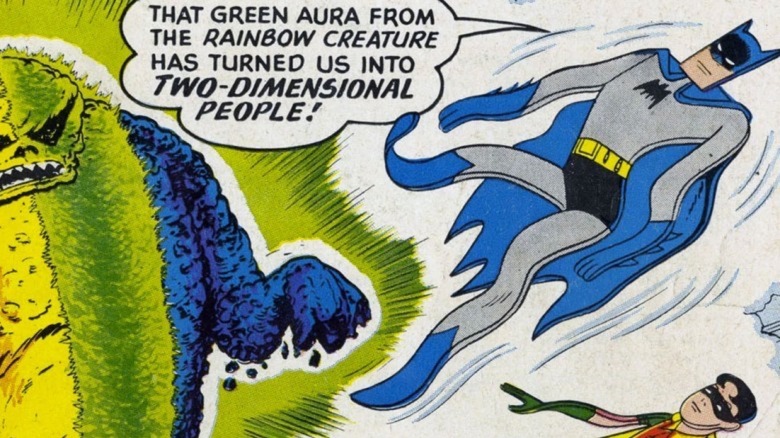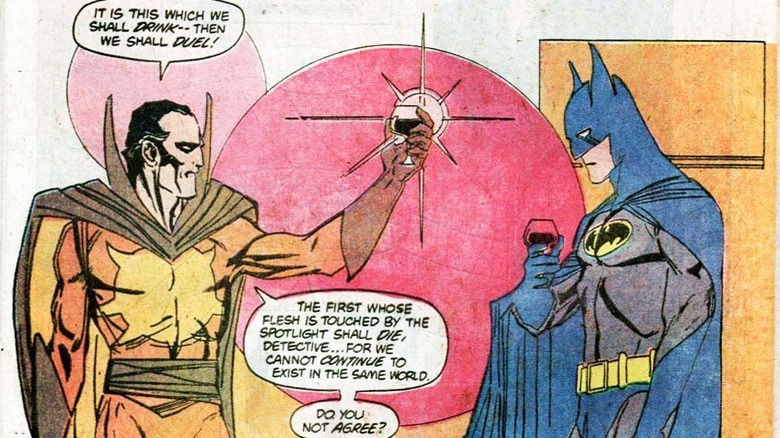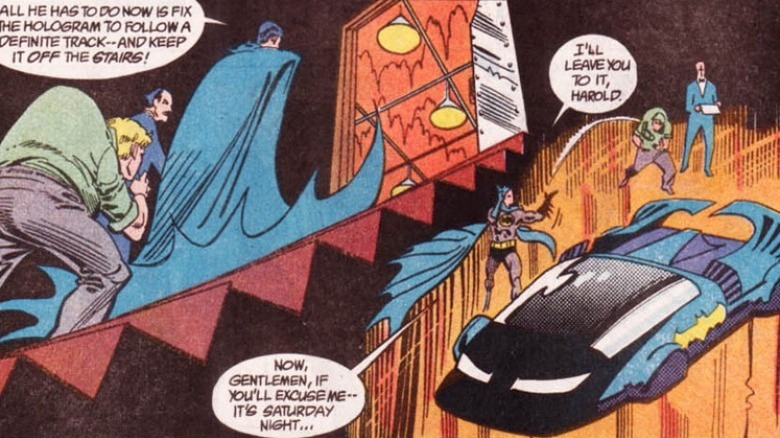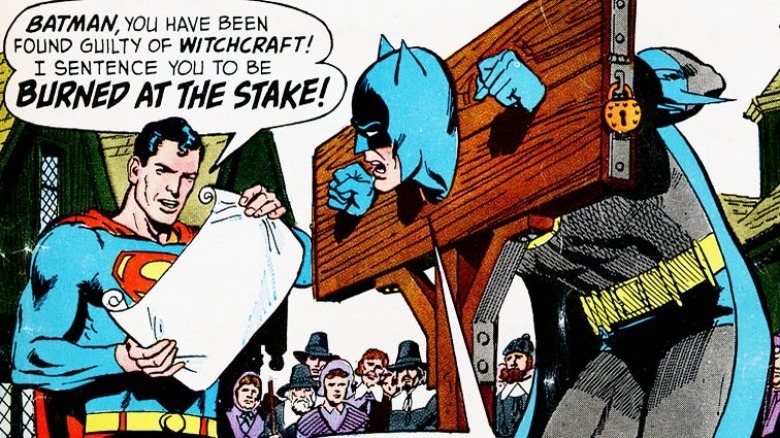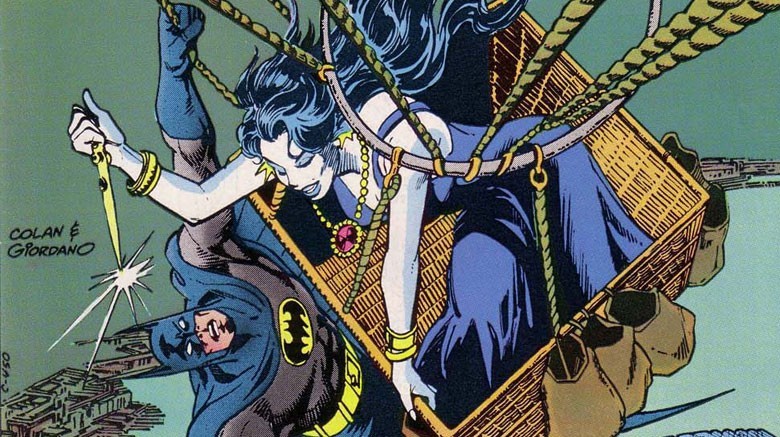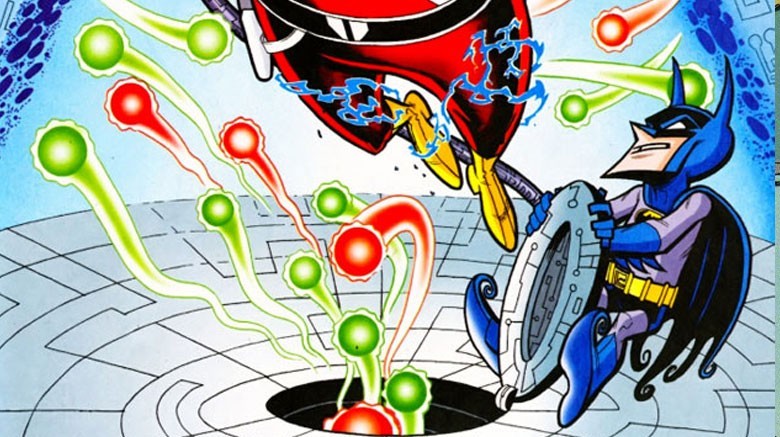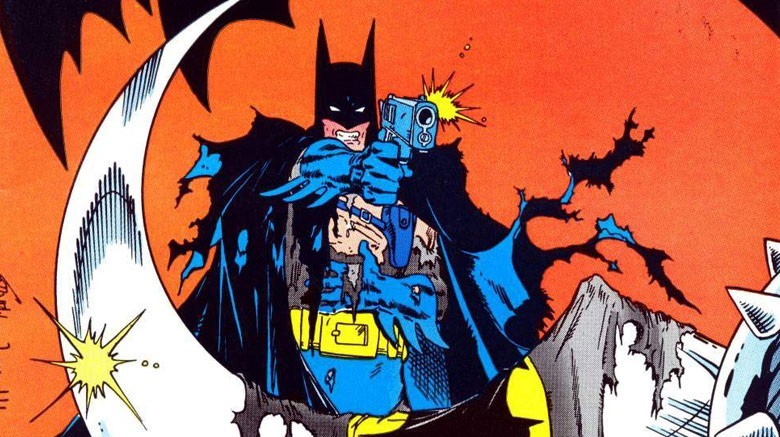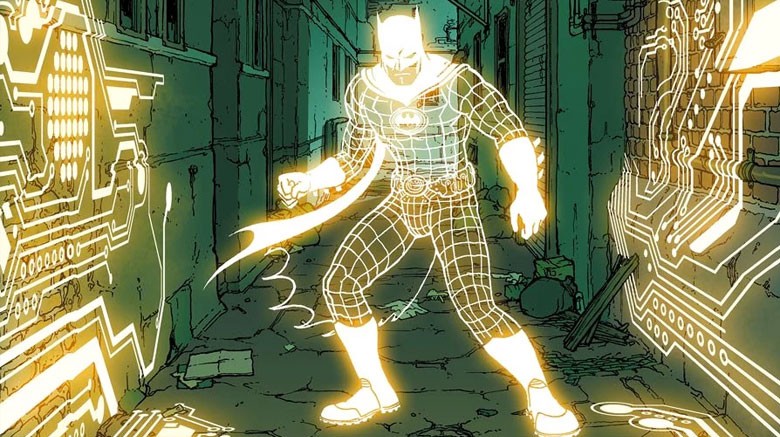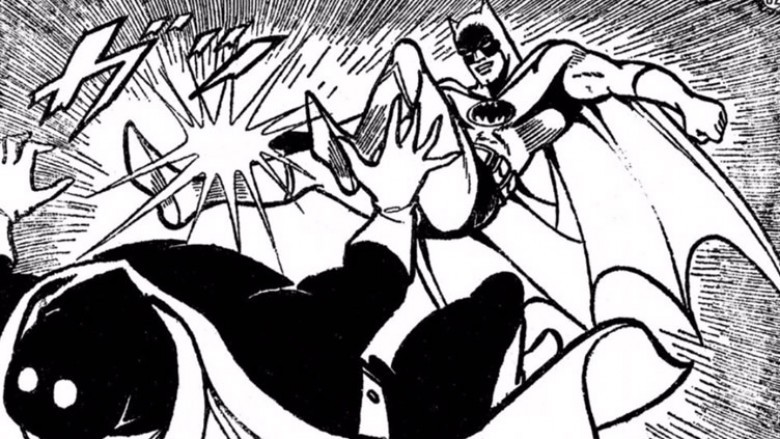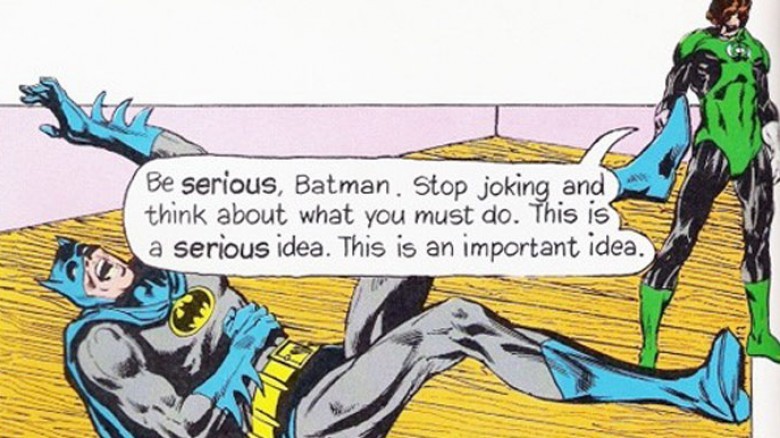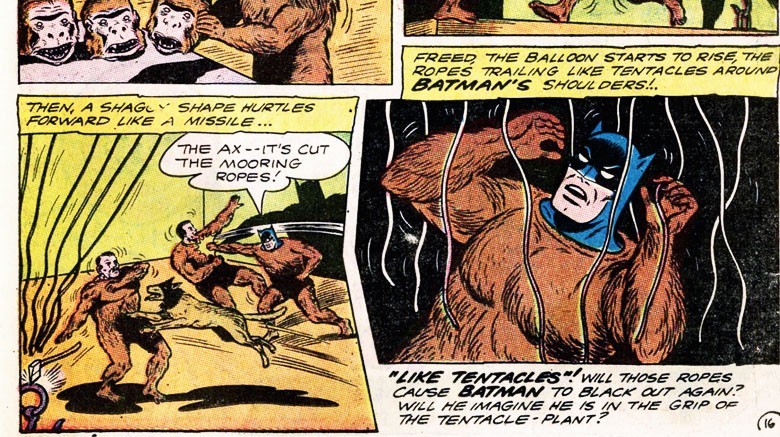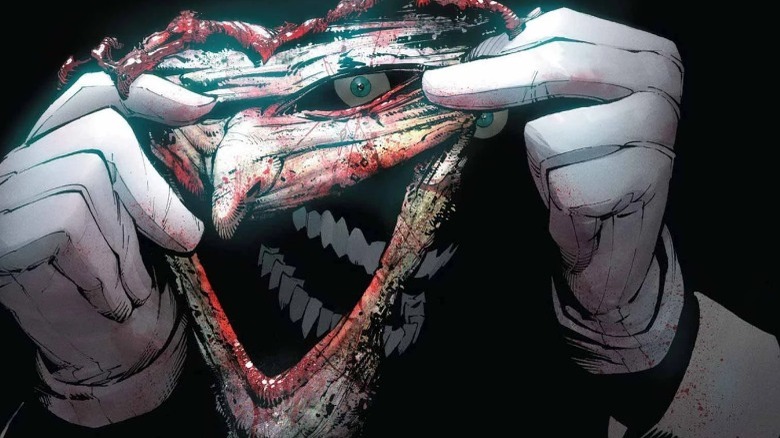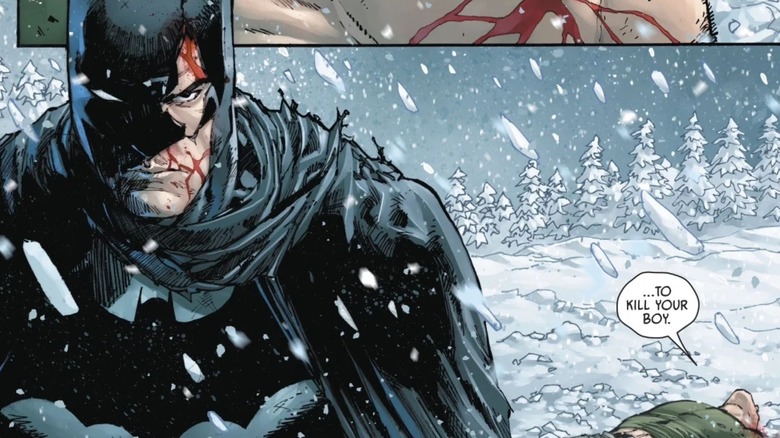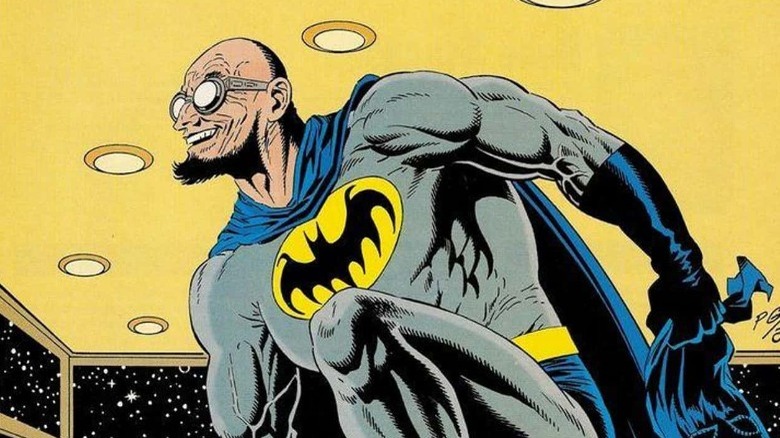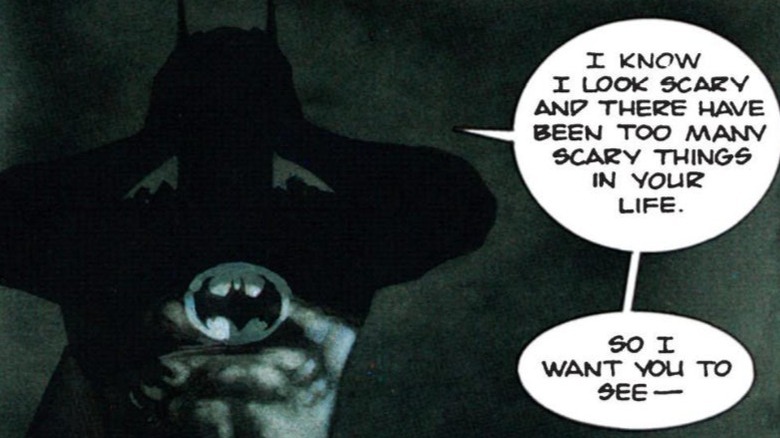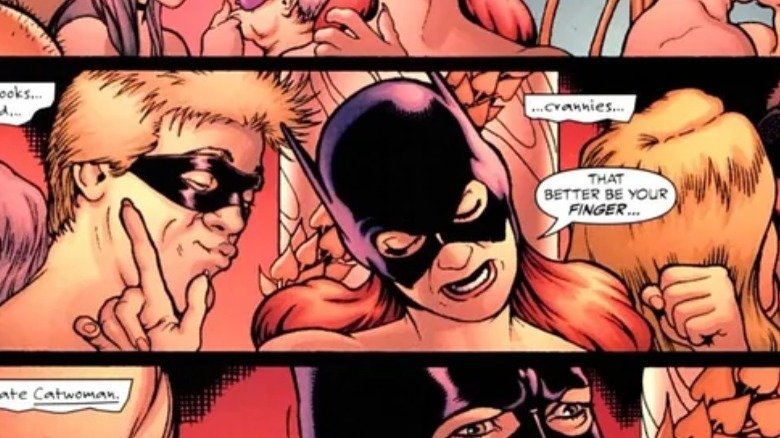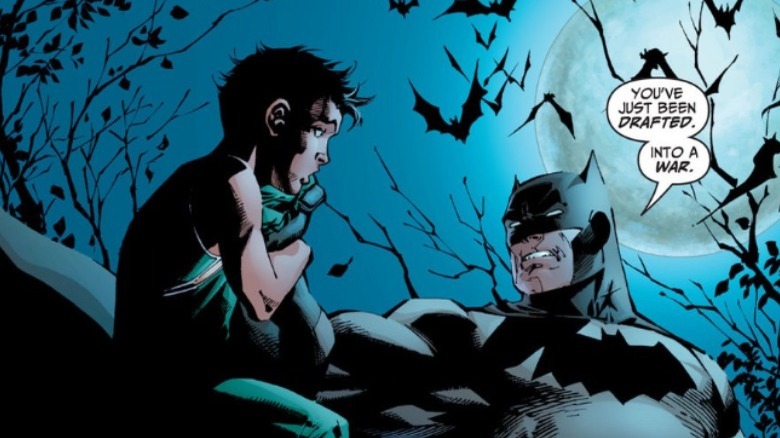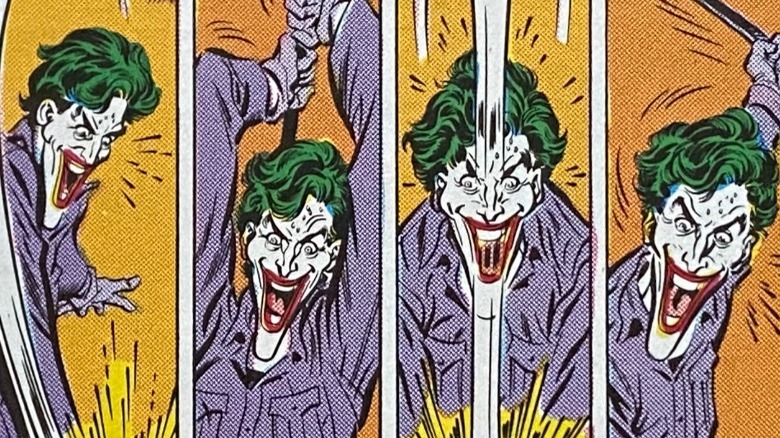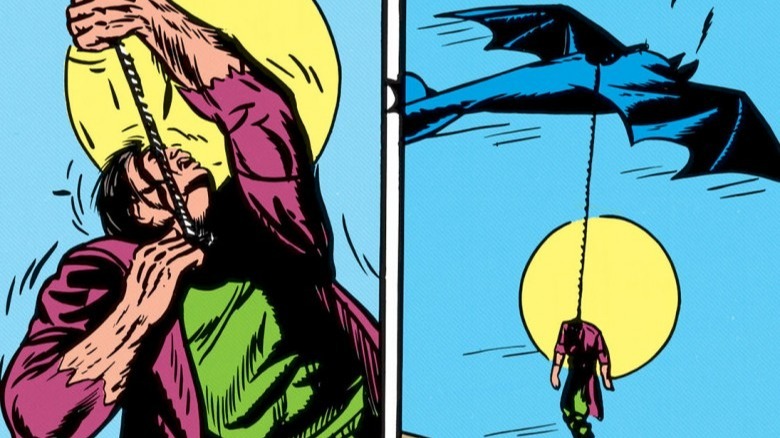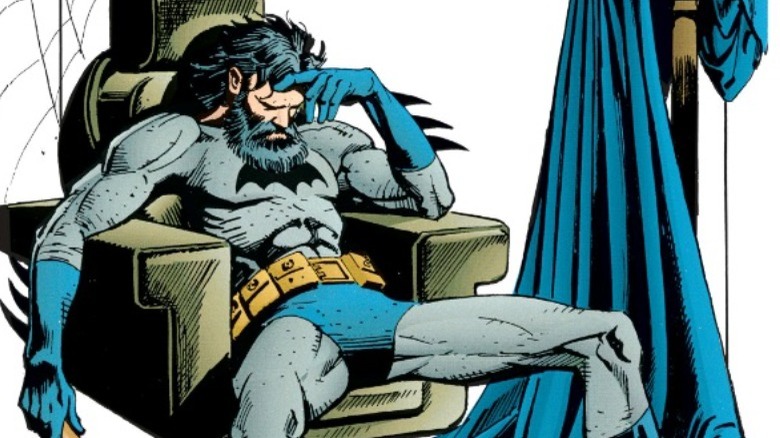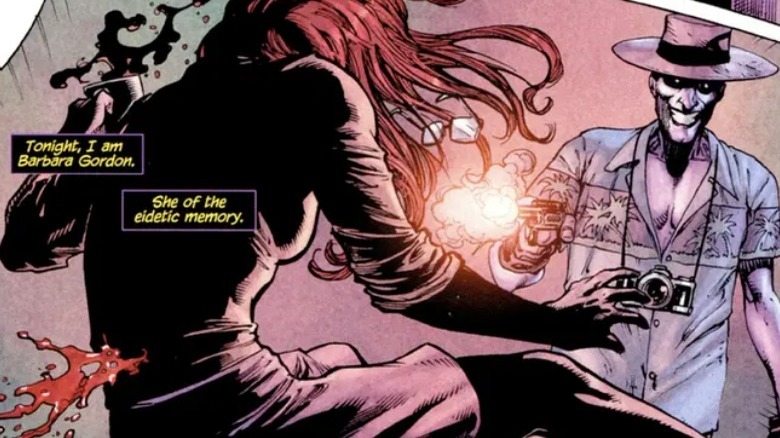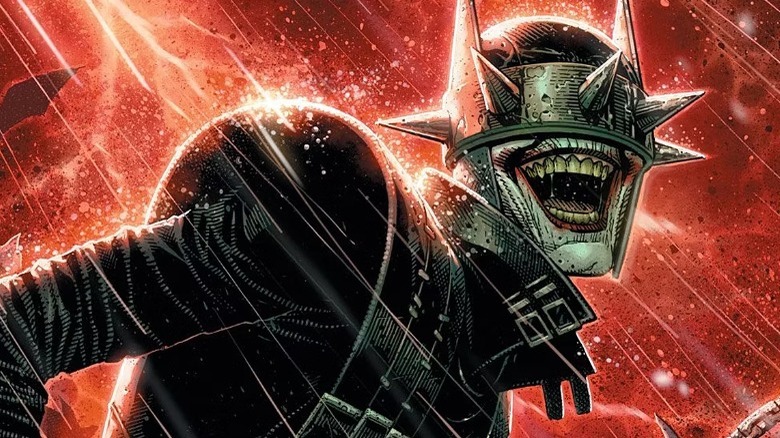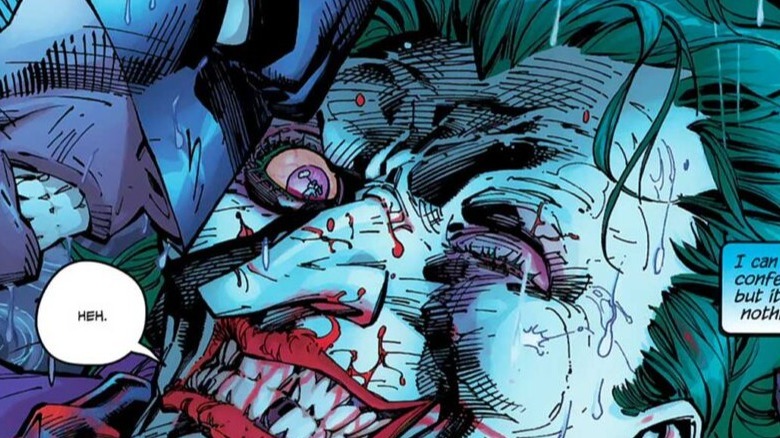Batman Moments That Will Never Be On The Big Screen
Say what you will about DC's attempts at moviemaking, but there's one thing you have to give the company: It goes out of its way to recreate moments from the comics. Movies like "Batman Begins" and "Batman v Superman: Dawn of Justice" are full of scenes lifted directly from the page. The problem, of course, is that the filmmakers tend to only pull from the same few stories, and while it's always nice to give fans something they recognize, it's a real shame when they don't dig deeper.
Eventually, they're going to realize that they have over 75 years of Batman comics to draw from, and when that happens, we're going to start seeing some really interesting stuff. That said, even when the filmmakers start going through long boxes and scouring the archives, there are going to be plenty of moments that are just too weird to ever be on the big screen.
Messiah of the Crimson Sun
If you saw "Batman Begins," then you might remember there was a little bit of controversy among fans when Batman decided to leave Ra's al-Ghul to his fate rather than save his life. The thing is, there's actually a lot of precedent in the comics for Batman to be a little callous with the life of his seemingly immortal foe. It's just that in the comics, it didn't involve a derailed train car exploding against the streets of Gotham City — it was more of a "vaporized with a space laser" sort of situation.
In Mike W. Barr and Trevor Von Eeden's "Messiah of the Crimson Sun," from "Batman Annual" #8, Ra's adopted the identity of a cult leader who proved his power by using an advanced satellite that could gather up sunlight and concentrate it into a devastating laser. Naturally, Batman stopped him, borrowing a space shuttle from NASA and heading off to orbit for some zero-gravity karate.
It's the sort of thing that feels more like a James Bond adventure than a Batman story — and it's probably not a coincidence that this story hit shelves only three years after 007 faced a similar setup in "Moonraker" – but the real money here is the ending. Ra's attempts to escape, only to have Batman tractor-beam him directly into the path of his super-laser and then open the hatch to allow his ashes to drift off into space. Ra's eventually came back, of course, but if he's going to make his return on film, odds are pretty good it won't be like that.
Harold Allnut
In the movies, the Dark Knight's seemingly endless arsenal of crimefighting equipment is either provided by Lucius Fox or made down in the Batcave by Alfred and Batman himself. It's a pretty good answer, as long as you don't think about it too hard and start wondering why nobody down in WayneTech R&D realizes they spend so much time sewing up wearable hang-glider capes and bat-shaped boomerangs. But honestly? It actually makes way more sense than what we got in the comics.
When Denny O'Neil, Alan Grant, and Norm Breyfogle decided to answer the question of who pumps the Batmobile's tires, the answer they came up with was Harold Allnut, who was both hunchbacked and mute, and also turned out to be a mechanical genius. After Batman rescued him, he moved into the Batcave and spent the next few years tinkering with the Batmobile and never leaving. Again, just so we're clear here: in the '90s, the Batmobile was built and maintained by a modern-day Quasimodo who never, ever went outside.
To make matters even weirder, his presence was rarely acknowledged despite the fact that he spent roughly a decade as a pretty prominent member of Batman's supporting cast. There would just be scenes in those comics when Batman would be down in the cave talking to Alfred about the Riddler or whatever, and there'd be someone hunched over a table in the background, silently working on his next project. He was eventually killed off in the pages of Jeph Loeb and Jim Lee's "Hush" after being briefly cured of his kyphosis in exchange for revealing Batman's secrets, only to be immediately murdered. Then he was even more improbably brought back in the pages of Scott Snyder and John Romita Jr.'s "All-Star Batman" #3, but this time, he didn't have to live in the basement — he was a tech expert living upstate from Gotham City who sent new gadgets to Batman via an underground river.
Trial of the Bat-Witch
The movies love to give Superman and Batman a reason to fight each other, and while they might've been content to just go with "because Lex Luthor said so" for now, eventually they're going to want to revisit that conflict and give it much higher stakes. But no matter what their next reason is for slugging it out in slow-motion big-screen combat, it's probably not going to involve traveling back in time and accusing each other of witchcraft.
That's exactly what happens in 1969's "World's Finest" #186, in which the Man of Steel and the Dark Knight head back in time to find out why real-life Revolutionary War hero "Mad" Anthony Wayne looks like Batman. The answer, of course, is that they're related, but along the way, Superman claims to be a traveling actor by announcing that the S on his chest stands for "Shakespeare" and then sets about convincing the good people of 1776 that Batman is a witch by disguising himself and flying around on a broom, using heat-vision to create fire, and using super-ventriloquism to make a black cat address Batman as its master. You know. Witch stuff.
This might seem out of character for Superman, but there's a good reason for it. He was possessed by a genie.
Nocturna
Despite the fact that Batman only has room for one true love in his life — the love of justice – the movies are always quick to try to add a little bit of romance. They've even made a point of creating entirely new characters just to give Batman someone to smooch, which seems a little weird. Why start your movies off with Vicki Vale and Catwoman, two characters drawn from the comics, and then move into movie originals without going any deeper? If they'd just done a little digging, we could've gotten a movie about Nocturna and the time Batman had a custody battle with a vampire over who got to raise Robin.
Okay, so Natalia Knight wasn't an actual blood-drinking vampire when Doug Moench and Gene Colan introduced her in "Batman" #363, but that's only because someone down at the Comics Code would've thrown a fit. She was, in fact, the victim of a radioactive accident that left her extremely pale and vulnerable to sunlight, happened to dress like Elvira, and was also an arch-criminal who adopted Jason Todd, discovered Batman's secret identity, and tried to convince the Caped Crusader that Robin could only be raised properly if they got married.
Even if it sounds like the best possible plot for a movie, a supernatural action-adventure rom-com in which Batman had to marry a sexy vampire criminal in order to get custody of his sidekick doesn't really sound like something we're going to be seeing on film. It's a shame, too. There's something for everyone.
Inventing Christmas with Adam Strange
This one seems like a no-brainer, right? Eventually, with superhero movies rapidly approaching critical mass to the point where we're getting something like five or six every year, someone's going to have to get the idea of making one where everyone's favorite superheroes save Christmas. Even if (when) that happens, though, it'll probably take the form of superheroes teaming up with Santa Claus rather than altering the fundamental nature of reality to create Christmas.
That's what happens in "Batman: The Brave and the Bold" #12, in which Landry Q. Walker and Eric Jones had Batman team up with spacefaring jetpack hero Adam Strange in a story that opens with Earth exploding on Christmas Eve and just gets weirder from there. By the end of it, Batman and Strange — who has a red-and-white costume — end up literally rebuilding the universe from within a reality-altering antimatter stream coincidentally made up of glowing red and green balls of light that twist their bodies. Strange ends up being stretched out and aged, with his rotund, bearded appearance imprinting on the subconscious mind of the rebuilt universe.
And Batman? Batman gets the opposite. He's the elf.
Batman: Year Two
As much as "Batman Begins" relied on Frank Miller and Mazzucchelli's "Batman: Year One" for inspiration, it's kind of surprising that nobody ever bothered to look at its canonical sequel: Mike W. Barr, Alan Davis, and Todd McFarlane's "Batman: Year Two," which ran in "Detective Comics" #575 to #578 just a year after its well-known predecessor. Or at least, that would be surprising, if "Year Two" wasn't the weirdest possible way to follow up the gritty, street-level reboot that would define Batman for the next 30 years.
To be fair, "Year Two" did have a pretty big influence on one theatrical "Batman" movie, the animated "Mask of the Phantasm." The title vigilante of that film and her relationship with Bruce Wayne owes more than a little to the Reaper, a gun-toting, scythe-wielding antihero who shows up in "Year Two" as a challenge for the Dark Knight. What that movie completely avoids, however, is everything else about the story — and that's where the weirdness comes in.
For one thing, it's revealed in this story that when his parents were murdered, Batman picked up the discarded handgun that killed them and kept it in a drawer for the next 15 years, in case he ever tracked down the mugger who shot them in Crime Alley. For another, the Reaper ends up being such a huge threat that Batman not only has to dig out his parents' murder weapon, he also has to team up with the mugger himself, Joe Chill. It's certainly the team-up you never expected, but ... that may actually be for the best.
Internet 3.0
You may think that Batman and "The Matrix" would be the two great tastes that taste great together, but if Internet 3.0 is anything to go by, you would be wrong. Very, very wrong.
When Internet 3.0 was introduced as an upcoming plot point, readers were teased with the idea of a virtual world that would spread out and form the underpinnings of the existing internet, bringing Batman into a futuristic world where he could battle cyber-crimes just as effectively as he took on the Riddler or Bane. It promised an idea that would combine punching with Zero Cool-style cyber hacking for a whole new digital realm of adventure. Batman even promised that his allies would have cheat codes. Cheat codes. What kid who grew up reading Nintendo Power didn't want to see that? There may be no spoon, but there would sure as hell be a Batarang thrown in there, right?
In practice, the one and only time Internet 3.0 was featured in a story — Grant Morrison and Scott Clark's "Batman Incorporated" #8 — it pretty much amounted to a murder mystery dinner in "SecondLife," only much more boring than that sounds. At least with that scenario, a 10-story neon purple fox might show up and demand that dogs be given the right to vote.
Professor Gorilla
Remember how weird it was to see the KGBeast showing up in "Batman v Superman," just sort of standing around as a human-shaped wink at anyone who bothered to Google "Anatoli Knyazev" to see if he was someone from the comics? Honestly, with the sheer number of characters in the DC Comics library, there's really no need to include anyone who didn't spend at least three months in Arkham Asylum, even if they're just lingering in the background being vaguely menacing.
On the upside, if these movies go long enough, the filmmakers are eventually going to have to get down to the villains they never would've thrown in otherwise — and that means characters like Professor Gorilla, also known as Karmak. Originally appearing in the "Batman" manga by Jiro Kuwata that ran in Japan's Shonen Ace magazine in the '60s, he was ... well, he was exactly what he sounds like. A gorilla who gained genius-level human intelligence and then tried to exact revenge on the entire human race.
While there are certainly people who would pay good money to see a movie where Batman had to battle against the scourge of super-intelligent gorillas — because seriously, if they're going to keep making "Planet of the Apes" movies, they might as well put Batman in at least one — the problem with Karmak might be that he's just too sympathetic to work as a villain. In the original story, even Robin admits "If I were a gorilla who got super-powers, I'd probably want to exact revenge on humans, too," and when you think about it like that, it might be the most solid argument for villainous behavior in the history of fiction.
The Super-Dictionary
If "The LEGO Batman Movie" proved anything, it's that a "Batman" film aimed at younger viewers can exist alongside a franchise that's trying to skew older and do just fine. Now that that's established, the logical next step is doing something that doesn't just appeal to kids but works as an educational project too. In other words, the world is crying out for an adaptation of 1978's "The Super Dictionary."
Even if you've never read it, you've almost certainly seen bits and pieces of The Super Dictionary floating around the internet, because the people behind it decided to use the weirdest possible examples to help kids learn new words. This is the book that taught us that Superman routinely delivers teaspoons to a giant who doesn't have any and that Lex Luthor stole 40 cakes — and that's terrible.
But it also gave us a moment that won't end up in a movie no matter how much it should: Batman rolling on the floor laughing his ass off while Green Lantern does his best to be serious. And honestly, he should laugh; whatever a guy with a magic ring from space is trying to tell a highly trained science ninja who just happens to like dressing up as a scary Dracula is probably going to be pretty hilarious if you really think about it.
Robin Dies At Dawn
If you were looking for a great story that dealt with the psychological trauma inherent in the idea of Batman, you could do a lot worse than to go back to Bill Finger and Sheldon Moldoff's "Robin Dies At Dawn." Originally printed in 1963's "Batman" #156, it's arguably the single best "Batman" story of the decade, showing a Batman who's struggling with, and ultimately overcoming, paralyzing fear that his life as a superhero will inevitably lead only to more death and suffering — specifically to Robin's, which would cause him to lose his only family a second time.
Of course, it's also a story that opens with Batman battling aliens in space and ends with him fighting crooks while wearing most of a gorilla costume over his bat costume because he's too afraid of bats, so, you know, there's that. As much as the themes might feel modern, the storytelling is pure Silver Age, with Batman volunteering to help an experiment on "space medicine" and ending up plagued by hallucinations of an alien world where he saw Robin die, leading him to temporarily give up on crimefighting until he gets his groove back.
That said, of all the stories on this list, this is the one that might actually make it. In 2008, Grant Morrison and Tony Daniel recontextualized it as a psychological experiment meant to break Batman down over the course of years, with the "space medicine" doctor being reintroduced as one of his deadliest enemies. That's the kind of thing the films can definitely work with, but we're guessing if they do, that gorilla suit ain't gonna make the cut.
The Joker's Face
Although the Joker is easily Batman's greatest foe and arguably the greatest villain in comic book history, he's featured in several stories that will never make it in a live-action film. Despite his widespread popularity, the character has a dark past, which means he has done some things inappropriate for mainstream blockbuster movies. One such example came in 2018 in "Detective Comics" #1 when the villain purposely gets himself captured and thrown in Arkham Asylum to enact a truly twisted plan.
While inside the facility's walls, the Joker encounters the Dollmaker. This serial killer is an expert surgeon who often removes flesh and skin from his victims to fashion hideous dolls, meaning the Dollmaker is unlikely to appear in a film anytime soon. Working with his new ally, the Joker has his face surgically removed — leaving behind a horrifying image of exposed tendons and flesh. According to the Joker, this was an attempt to show that his insanity and persona were not simply a result of his "mask" but rather his entire being.
After the surgery, the Joker pinned the mask on a wall inside Arkham Asylum for Batman to find before fleeing and remaining undetected for a significant time. He later returned wearing the face again, attaching it via clips and thread.
Snapping KGBeast's neck and leaving him to die
KGBeast has been a regular foe of Batman since he was introduced in 1988 during the events of "Batman" #417. Trained by the KGB as an assassin, KGBeast is often known by his birth name, Anatoliy Knyazev, and has killed hundreds of people throughout his deadly career. A master of martial arts and skilled with almost every type of weapon, KGBeast also has several cybernetic enhancements to augment his strength, endurance, and speed. The villain has fought with the Caped Crusader dozens of times and returned in 2018 during a three-issue arc known as "Beasts of Burden."
This story, which takes place between "Batman" #55 and #57, sees KGBeast return to Gotham to confront his longtime adversary on behalf of Bane — who is masterminding a war against Batman. He fights Nightwing and almost kills the vigilante, leading Batman to seek out KGBeast to stop his machinations. The graphic brawl concludes when Batman's zipline seemingly breaks KGBeast's neck.
With the villain apparently suffering fatal injuries that leave him motionless on the floor, Batman walks away, with KGBeast being slowly covered with snow. As the fight took place in such an isolated area, it appeared as if the hero simply decided to leave his foe to slowly die, as he is buried alive by snow. However, it is later revealed that KGBeast survived.
Batman killing Hugo Strange
Having first appeared in "Detective Comics" #36 in 1940, Hugo Strange is one of Batman's oldest enemies. A genius-level psychologist, Strange is deeply obsessed with Batman and is determined to leave behind a legacy greater than the hero's. Strange has shown he's capable of discovering the Dark Knight's true identity and constantly trains to try to best him in terms of physicality and intelligence. His longevity in DC Comics has ensured he's been a constant thorn in Batman's side for decades, and his depravity has pushed Bruce Wayne to his limit many times.
During Batman's very first encounter with Strange, with the villain attempting to turn the hero into a mutated giant monster, the two fight, and he falls from a tall cliff to what appears to be his death. A few months later, in "Detective Comics" #46, Strange returns but seemingly dies again after falling from another cliff. This time, though, Batman purposely punched Strange and directly caused him to fall, apparently breaking his rule never to kill anyone.
That's not the only time Strange has been involved in a controversial moment. He has been shown to blow himself up on several occasions in an attempt to kill Batman. In one of these instances, Strange strapped explosives to him after being diagnosed with cancer in an attempted murder-suicide that Batman survived.
If you or someone you know is struggling or in crisis, help is available. Call or text 988 or chat 988lifeline.org
Batman: Night Cries
The nature of Batman as a brooding and dark hero means that there are always some stories more mature than others. While plenty of traditional DC Comics show a grislier side to the Dark Knight, his most ominous tales have often come in one-shots or graphic novels. A great example of that is "Batman: Night Cries." Released in 1992, it was written by Archie Goodwin, with art principally done by Scott Hampton, and follows Batman as he and Commissioner James Gordon track down a serial killer.
"Batman: Night Cries" quickly delves into morality when it is revealed this killer is a masked vigilante bringing a gruesome form of justice to child abusers. There are harrowing accounts from children who have had their innocence ripped away, and although nothing explicit is ever shown, there are moments that can have the emotional weight of a kick to the chest.
Batman and Gordon must come to grips with the devastating cases they see, weigh whether this killer is justified, and confront their personal demons. The comic delves into how Gordon cares more for the job than his own family, depicting him nearly hitting his son before stopping himself. The entire story is beautifully written and drawn, but something major movie studios would avoid like the plague because of its complicated and controversial subject matter.
If you or anyone you know has been a victim of sexual assault, help is available. Visit the Rape, Abuse & Incest National Network website or contact RAINN's National Helpline at 1-800-656-HOPE (4673).
If you or someone you know may be the victim of child abuse, please contact the Childhelp National Child Abuse Hotline at 1-800-4-A-Child (1-800-422-4453) or contact their live chat services.
Batgirl attends an orgy
Compared to many dark or disturbing moments from the world of "Batman" that would never make it to the big screen, this particular moment is unlikely to be adapted for a very different reason. Released in 2008, "Batman Confidential" #18 follows Batgirl as she hunts down Catwoman. The villain and occasional hero steals Commissioner James Gordon's notebook. Determined to get back her father's belongings and discover what Catwoman wants, Batgirl discovers that she is hiding within Gotham City's Hedonist Society.
As you might have guessed from the name, this is a sex club where members of Gotham's high society can engage in orgies without judgment. The problem arises when Batgirl is refused entry unless she follows the strict rules — which include clothing being forbidden outside of a mask to hide the identities of those within. This leads to Batgirl having to deal with her issues about her body image and contains some imagery that probably wouldn't be great for a family-friendly superhero movie. After all, most comic book films tend to be far more willing to depict intense violence than nudity.
Batman uses the R-word
Frank Miller is one of the world's most respected comic book writers. Having won every major award for his work in the industry, he is also responsible for some of the most important "Batman" comics. Arguably his most prominent release was "Batman: The Dark Knight Returns," a 1984 miniseries that helped propel the franchise into a grittier and more mature setting. Of course, that doesn't mean that everything Miller has worked on has been a hit. For example, his "All-Star Batman And Robin, the Boy Wonder" series has been widely panned for portraying Bruce Wayne out of character.
Much of this is to do with the way Batman treats Dick Grayson. Essentially kidnapped by Batman after witnessing the death of his family, Grayson is trained to become the new Robin and suffers physical and mental abuse at the hands of the Caped Crusader. In what became a popular meme, Batman, at one point, even uses the R-word when talking to Grayson, saying: "What are you, dense? Are you re***ded or something? Who the hell do you think I am? I'm the goddamn Batman!"
At another point in the story, Batman slaps his sidekick across the face and shouts down at Alfred when the butler shows any kindness towards the young Grayson, who is still mourning the death of his entire family. Batman doesn't even provide his ward with food and instead suggests he hunt for rats in the Batcave.
Jason Todd's gruesome death
For many people, Jason Todd is best known as the Red Hood, a violent antihero who comes back into Batman's life and causes some issues for the Dark Knight. But long before the events of "Batman: Under the Hood," Jason Todd was the replacement Robin following Dick Grayson's retirement. However, his time as Batman's sidekick was short-lived, as the Joker violently murdered Todd.
Todd's death happened in "A Death in the Family," a 1988 story running from "Batman" #426 to #429. Controversially, DC Comics allowed fans to decide Todd's fate, with readers able to call in and vote whether he would be killed or survive the Joker's attack. In the end, fans narrowly chose to have this version of Robin die. After being kidnapped by the villain and viciously beaten with a crowbar, Todd was killed by an explosive while trying to shield his mother from the blast.
Batman spent a significant amount of time after his sidekick's death dealing with guilt from being unable to save him. Yet, the gruesome and brutal violence Todd suffers makes this such a controversial moment and a step too far even for R-rated movies.
The hero hangs a victim for everyone to see
The early days of "Batman" comics were a weird world. The character was still being fleshed out while writers were experimenting with how Batman would act and how far he was willing to go. For example, his no-kill rule was not established until the winter of 1940 in "Batman" #4, a year after his debut in "Detective Comics" #27. Until that point, Batman didn't seem to have any issue with using lethal force — something effectively demonstrated in "Batman" #1.
In this comic, Batman is once again fighting against Hugo Strange, who has created an army of mutated Monster Men causing havoc throughout Gotham. After convincing several of them to fight each other, he captures a second one by using a machine gun to destroy the vehicle the Monster Man is using. Swinging a rope around this adversary's neck, Batman hangs the figure from the Batplane, parading the body over Gotham as it slowly stops struggling and becomes limp. It's a dramatic image considering Batman is usually against using lethal force and is backed up later in the same issue when the hero disables another Monster Man and causes him to fall to his death.
Batman battles addiction
Most people will probably associate the highly addictive super-steroid drug known as Venom with Bane, but the substance has a long history in DC Comics. The first character shown abusing the drug was actually Batman. During the events of the "Batman: Venom" storyline in "Batman: Legends of the Dark Knight" #16, the Dark Knight fails to save a young girl's life. This throws Batman into a deep depression and sets him on a path to try and achieve physical perfection because he views his previous failure as a consequence of his limitations.
To do that, he starts abusing Venom to take his body to its maximum. The story humanizes the hero and depicts a man attempting to deal with what he perceives are his inadequacies by taking extreme measures. Batman quickly becomes entirely dependent on Venom and realizes its negative effect on his life despite providing him with more strength than previously possible. No more a brute force of a weapon than his intellectual and analytical self, the comic shows Batman at his worst before he goes cold turkey and has Alfred lock him in the Batcave for a month.
If you or anyone you know needs help with addiction issues, help is available. Visit the Substance Abuse and Mental Health Services Administration website or contact SAMHSA's National Helpline at 1-800-662-HELP (4357).
The Killing Joke
Barbara Gordon has had a tough time in the "Batman" continuity. Like many members of the Bat Family, she has had her fair share of hardships and had to put up with a lot of punishment as both Batgirl and Oracle. However, arguably the most disturbing thing she had to endure came in "The Killing Joke," a one-shot from "Watchmen" writer Alan Moore. Not only is it one of the most horrifying moments in "Batman" comics, but also one of the most controversial in DC Comics' entire history.
The story primarily revolves around the Joker's mission to make James Gordon snap and become as mentally unstable as himself. Believing that every person is capable of that same kind of depravity, the Joker goes to ever more extreme lengths to prove his theory, which involves torturing Batgirl. The villain shoots her through the spine, paralyzing her, and then forces her to struggle on the floor strewn with glass, unable to get up and in agonizing pain. The Joker then goes on to undress Batgirl and photograph her, sending the photographs to Commissioner Gordon.
Batman Who Laughs
Among the many dark stories featuring Batman, arguably the most frightening and harrowing is "The Batman Who Laughs." The character was introduced in "Dark Days: The Casting" #1 but was made the main character in "The Batman Who Laughs" #1 and #2, as well as "Dark Nights: Death Metal." An alternate version of Bruce Wayne, this Batman was turned into a hideous hybrid by the Joker. Having killed every one of Batman's major enemies, the Joker makes his nemesis snap and kill him after murdering the parents of several children in front of him.
However, in his dying breath, the Joker exposed Batman to a toxin that transforms him into a depraved version of himself, but with all the intellect of Bruce Wayne. In the resulting carnage, Batman kills every one of his allies, forces his son to turn into a mini-Joker, and sets off to take over the world. He eventually confronts the Justice League and brutally kills every member before forcing Superman and Jon Kent to go into a frenzy by exposing them to Black Kryptonite — an act that leads them to kill each other and a helpless Lois Lane.
Brutally beating the Joker
Although Batman has certainly had more reckless moments and even came close to killing the Joker on several occasions, none have been quite so violent and crazed as a particular incident in "Batman: Hush." Written by Jeph Loeb, with art by Jim Lee and Scott Williams, the story focuses on a relatively new villain in the "Batman" mythos known as Hush. Once a childhood friend of Bruce Wayne, Hush develops a vendetta against the Waynes and wants nothing more than to destroy Bruce and his reputation.
Before Hush even appears, Batman is forced to battle several of his oldest enemies, who act out of character. This culminates in the Joker seemingly shooting noted surgeon Dr. Elliot dead, an act that finally pushes an exhausted Batman over the edge. In a rage, the hero savagely beats his nemesis, almost killing him despite the protestations of several of his friends, who try to stop him.
Commissioner Jim Gordon eventually ends the madness, and it is later revealed that Hush framed the Joker. Batman committing such a violent attack is something movie fans will likely never see in a live-action adaptation.
